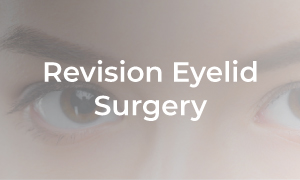Upper Blepharoplasty
Upper Blepharoplasty (correction of droopy eyelid)
As aging occurs, the skin of the upper eyelid becomes loose and droopy. The upper eyelid appears thick, heavy, and saggy, making the eyes look tired and sad. In severe cases, the upper eyelid even covers part of the eye and affect vision. The medical term for this condition is called dermatochalasis of the upper eyelid. Upper blepharoplasty is a minor surgical procedure performed to remove the redundant skin from the upper eyelid. Removal of excessive fat and tightening of the eyelid muscle are performed as well if indicated. The aim of upper blepharoplasty is to correct droopy eyelid and make the eyes appear more alert and youthful.
For droopy eyelid caused by ptosis (short for blepharoptosis), please refer to Ptosis Repair
Preparation
-
-
-
Inform the doctor of any pre-existing medical conditions and drug allergy. All medical conditions must be treated and stabilised before surgery.
-
Stop smoking at least one week before surgery. Smoking is harmful to wound healing and increases the risks of other post-operation complications.
-
Stop the following medications and supplements from one week before surgery until one week after surgery.
-
All supplements containing vitamin E, ginseng, ginkgo, garlic, fish oil, and other ingredients that increase bleeding during the procedure. Other supplements, traditional medicine, and herbs, in which ingredients are unknown, have to stop as well.
-
Medicine that increases bleeding during the procedure such as aspirin, NSAIDs, and warfarin. However, you may need to consult your physician who prescribed the medication before you stop them.
-
-
On the day of surgery, wear simple and comfortable clothing and do not wear any makeup. Do not wear any jewelry and metal objects on the face and body.
-
Bring a pair of sunglasses on the day of surgery for use after surgery.
-
Don’t wear contact lenses on the day of the surgery.
-
-
Surgery
Duration: 1-2 hours
Anaesthesia: Local anaesthesia
Hospitalization: Not required.
Recovery*: Back to work in 3-7 days, light exercise after 7 days, heavy exercise after 2-3 weeks.
*The actual speed of recovery may vary from person to person
Surgery Technique: An incision is made on the upper eyelid skin. Excess skin is removed. Fat removal and tightening of the eyelid muscle (levator palpebrae superioris) are performed if required. The incision scar is hidden in the double eyelid crease and is not visible when the eye is open. Upper blepharoplasty scars usually heal very well and not noticeable.
Post-operative Care**
-
-
-
What to expect: Swelling usually peaks on the second to third day after surgery and will gradually subside after that. Post-operative pain is usually minimal.
-
General care:
-
Apply cold pack in the first 3 days and then warm pack for the following 3 days. Elevate the head during sleep to reduce swelling.
-
Avoid smoking for at least one month. Smoking increases the risk of wound complications.
-
Use sunglasses for protection when going outdoors.
-
Good rest and adequate sleep are helpful for a speedy recovery.
-
Be relaxed and calm. Contact the clinic if there are any queries.
-
Don’t use contact lenses for at least 2 weeks.
-
-
Medicine: Finish the oral antibiotics as prescribed. Take the painkiller when necessary.
-
Wound care: Clean the wound with a clean cotton tip soaked with sterile water/saline. Apply antibiotic ointment. No dressings are required.
-
Physical activity: Avoid heavy physical activities and exercises for at least one month.
-
Follow-up: Come back one week after surgery for suture removal and review.
-
Emergency: If there is heavy bleeding, a rapid increase in swelling or severe pain, contact the clinic/doctor for advice immediately.
-
-
** The instructions in this list are only general guidance. If you have any specific queries or concerns during the post-operative recovery, please contact the clinic for further advice.








